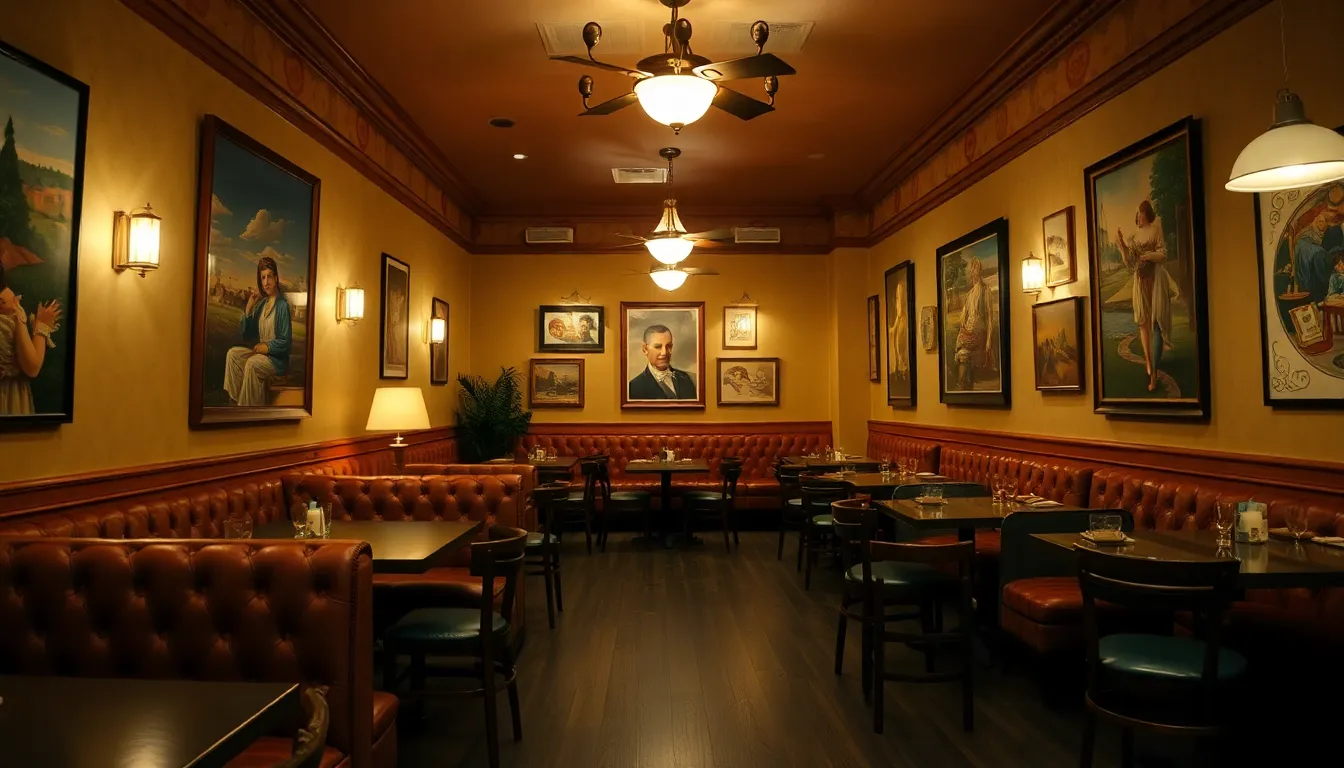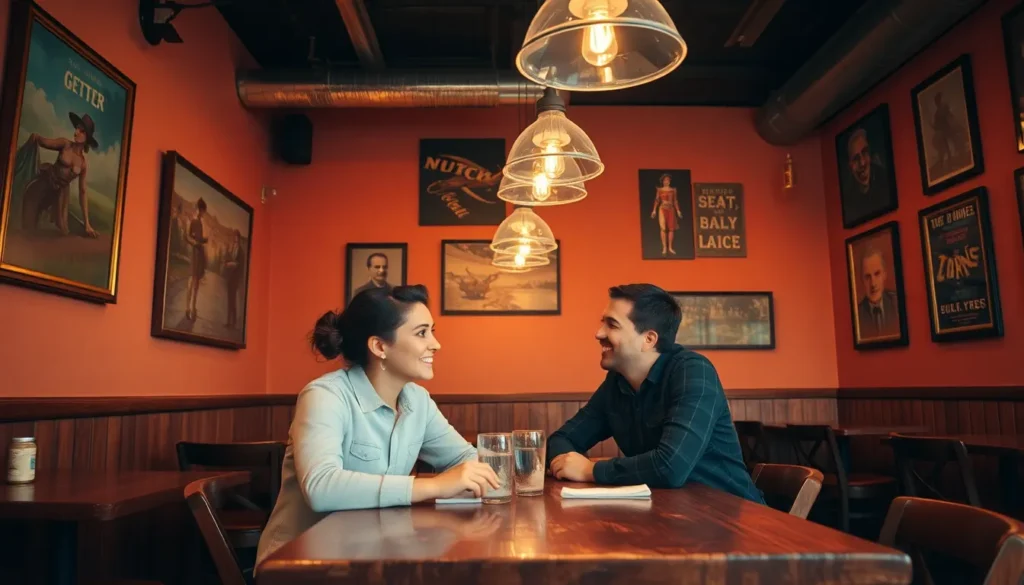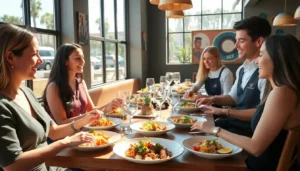Table of Contents
ToggleWhen it comes to dining out, the food might steal the show, but let’s be real—restaurant decor is the unsung hero. Imagine sinking your teeth into a delicious meal while surrounded by whimsical artwork or cozy lighting that makes you feel right at home. The right decor doesn’t just set the mood; it transforms a simple meal into an unforgettable experience.
Overview of Restaurant Decor
Restaurant decor shapes the overall dining experience and influences customer perceptions. It encompasses a range of elements, including furniture, color schemes, lighting, and artwork. Specific decor choices communicate a restaurant’s concept and theme, attracting target customers.
Furniture selection matters. Comfortable seating encourages patrons to linger, while table arrangements facilitate conversation. Both factors significantly enhance the atmosphere. Color schemes also play a pivotal role. Warm tones can create an inviting ambiance, while cool shades foster relaxation.
Lighting sets the mood for diners. Bright lights may energize a space, while dim lighting promotes intimacy. Strategic use of natural light can enhance aesthetics, too. Furthermore, artwork and decor accents add character and can evoke emotions. Unique pieces spark conversations and contribute to the restaurant’s identity.
Consistency is crucial in decor choices. A cohesive theme reinforces a brand’s message and encourages a memorable dining experience. Modern establishments may opt for minimalistic designs, whereas traditional venues often embrace ornate details. Texture integration, such as wood or metal, adds depth to the environment and enhances visual appeal.
Attention to detail elevates decor quality. Seasonal decorations make a space feel fresh and can attract repeat visitors. Branding elements, such as logos or color palettes, should also be integrated seamlessly into the decor for enhanced brand recognition. Thoughtful design choices lead to a more engaging and enjoyable atmosphere for diners.
Importance of Restaurant Decor

Restaurant decor significantly affects the dining experience by influencing the atmosphere and customer perceptions. Elements like color, lighting, and furniture contribute to a memorable meal.
Enhancing Customer Experience
Comfortable seating arrangements encourage guests to relax and savor their dining experience. Thoughtful table layouts promote conversation and foster a sense of intimacy among patrons. Color schemes play a vital role, with warm tones creating a cozy ambiance and cool hues offering calming effects. Unique artwork draws attention, inspiring engagement and forming emotional connections. Natural light enhances the space’s overall appeal and affects diners’ moods positively. Each of these decor elements works together to elevate a routine meal into an unforgettable outing.
Impact on Brand Identity
Restaurant decor communicates the brand’s essence and concept effectively. Consistent design elements reinforce the establishment’s theme, attracting target customers. Minimalistic designs indicate modernity, while ornate details reflect traditional values. Distinctive decor choices also create memorable experiences, leading to positive word-of-mouth and brand loyalty. Seasonal decorations can dynamically alter the ambiance, preserving freshness in customer perceptions. Understanding these connections aids owners in establishing a strong brand identity that resonates with their audience.
Popular Restaurant Decor Styles
Restaurant decor significantly influences customer experiences. Various styles create distinct atmospheres that attract different demographics.
Modern Minimalist
Modern minimalist decor emphasizes simplicity and functionality. Clean lines, neutral color palettes, and uncluttered spaces characterize this style. Furniture typically features materials like wood, metal, and glass, creating a sleek look. Ambient lighting complements the decor, enhancing the overall clean aesthetic. Open floor plans allow for social interaction and create an airy feel. Diners often appreciate the focus on quality over quantity in these environments. Art is usually limited to a few curated pieces that resonate with the brand. Spaces adorned with thoughtful design invite relaxation and foster a sense of calm.
Rustic Charm
Rustic charm brings warmth and intimacy to dining experiences. Natural materials such as reclaimed wood, stone, and metal dominate the decor. These elements evoke a cozy atmosphere, making patrons feel at home. Vintage furniture and handmade decor items often reflect local craftsmanship. Warm, earthy tones enhance the inviting vibe, allowing diners to unwind. Lighting typically consists of soft hues, often from wrought iron fixtures or candles. Seasonal accents, like floral arrangements or festive decorations, contribute to the rustic appeal. This decor style often attracts families and couples seeking a comforting dining environment.
Vintage Elegance
Vintage elegance offers a blend of nostalgia and sophistication in restaurant decor. Ornate furniture and classical design elements create an upscale ambiance. Decor often features rich colors and lavish textures, enhancing the luxurious feel. Antique items like chandeliers or vintage mirrors contribute to the aesthetic charm. Soft, ambient lighting enhances the elegant atmosphere, making it perfect for special occasions. Tablescapes reflect attention to detail, often adorned with fine china and polished silverware. Floral arrangements and vintage art pieces foster an intimate setting that resonates with history. This style often attracts patrons seeking a refined dining experience.
Elements of Effective Restaurant Decor
Effective restaurant decor combines various elements to enhance the dining experience. Each component plays a distinct role in creating ambiance and attracting patrons.
Color Schemes
Color schemes significantly influence mood and perception within a restaurant. Warm tones, such as reds and oranges, encourage energy and sociability, making them ideal for lively establishments. Cool hues, like blues and greens, promote relaxation, appealing to diners seeking tranquility. Each color choice must align with the restaurant’s theme, reinforcing its brand identity. Additionally, combining colors can create visual interest. Strategic use of color enhances overall aesthetics and can guide customer flow through the space.
Furniture and Layout
Furniture and layout directly affect comfort and functionality in a restaurant. Comfortable seating sets the stage for longer visits and meaningful conversations. Arranging tables to facilitate movement and interaction maximizes space efficiency. Styles of furniture should complement the restaurant’s theme, whether casual or formal. For example, rustic charm utilizes reclaimed wood tables, while modern aesthetics favor sleek designs. Distinct layouts can foster intimacy or encourage group gatherings, impacting customer satisfaction. Each choice in furniture and layout helps shape the overall dining experience.
Lighting Solutions
Lighting solutions create the desired atmosphere and influence diners’ emotions. Natural light enhances warmth and openness, attracting guests during the day. For evenings, adjustable lighting offers flexibility; dim lighting fosters a cozy, intimate setting. Bright lights energize spaces, ideal for busy environments, while accent lighting highlights décor elements or artwork. Layering lighting types, such as ambient, task, and decorative, enhances visual appeal and functionality. Thoughtful lighting choices contribute to a memorable dining experience, directly impacting customer enjoyment.
Restaurant decor is more than just aesthetics; it’s a vital component of the overall dining experience. Thoughtful design choices can transform a meal into a cherished memory. By carefully selecting elements like furniture, color schemes, and lighting, restaurant owners can create an atmosphere that resonates with their target audience.
Unique decor not only enhances comfort but also fosters emotional connections with diners. As patrons engage with their surroundings, they’re likely to return and share their experiences with others. Ultimately, a well-executed decor strategy can significantly boost customer satisfaction and loyalty, making it an essential aspect of any successful restaurant.







